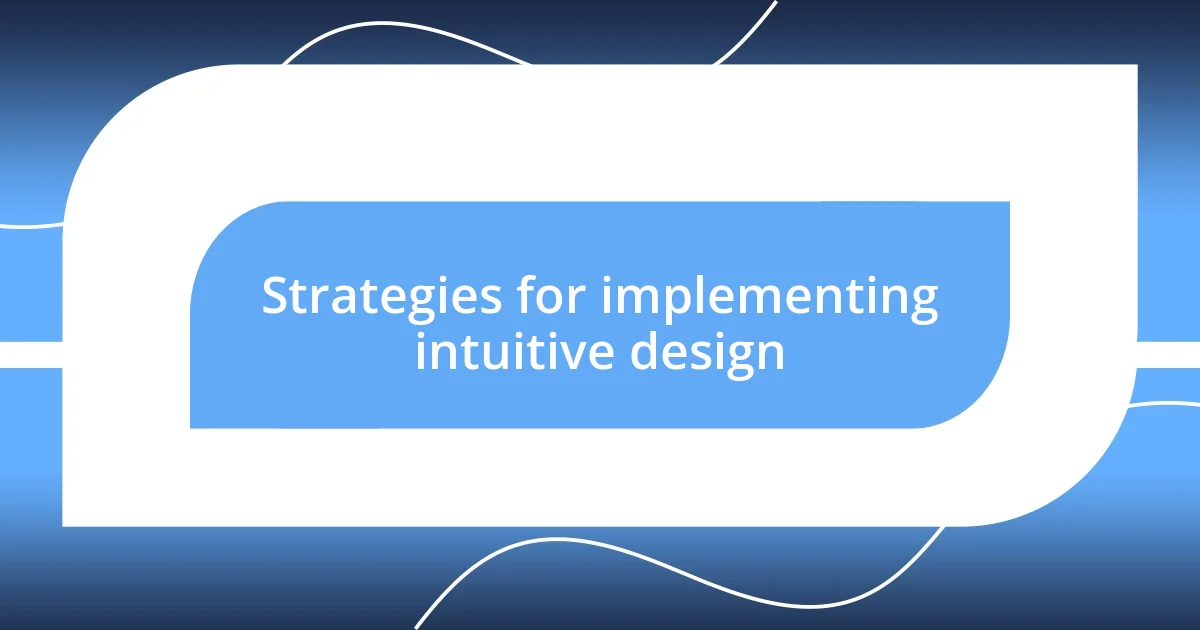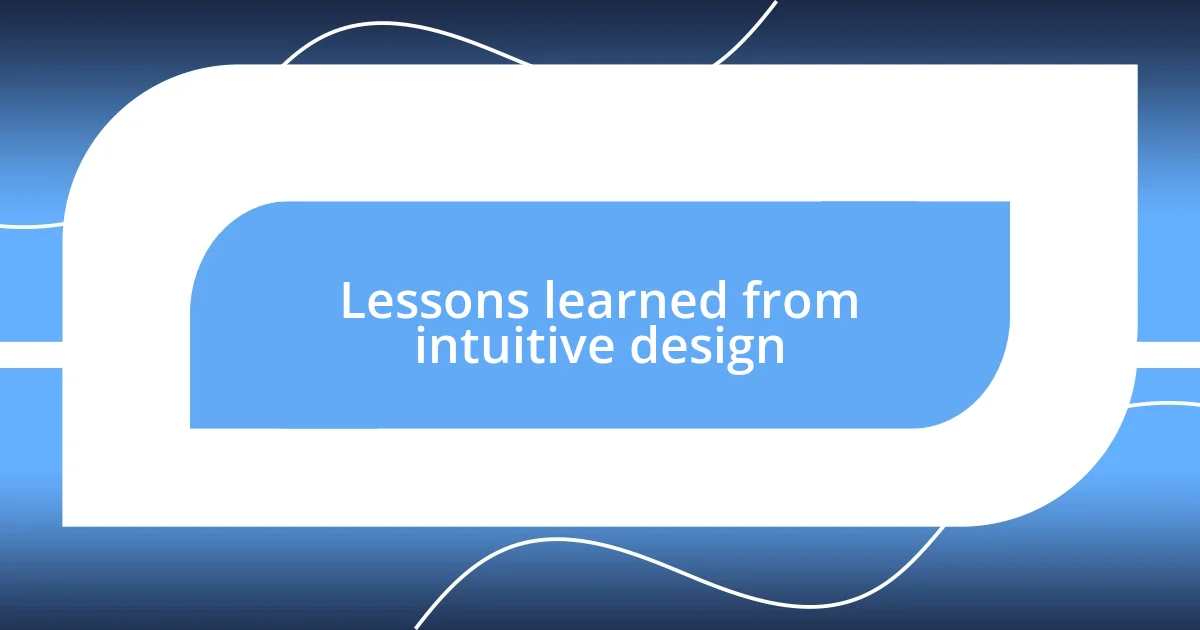Key takeaways:
- Intuitive design relies on empathy, simplicity, and user feedback to create seamless, user-centered experiences.
- Consistent visual elements and clear navigation enhance user confidence and aid decision-making by reducing confusion.
- Iterative design processes, including early user testing and collaboration across diverse teams, lead to improved outcomes and innovative solutions.

Understanding intuitive design principles
Intuitive design is all about creating experiences that feel natural and effortless. I remember the first time I used a beautifully designed app that seemed to read my mind. Interactions flowed seamlessly, making me feel confident and in control. Isn’t it incredible when technology feels almost human?
At the heart of intuitive design lies the principle of user empathy. Reflecting on my own experiences, I often find frustrating interfaces make me question if designers ever considered my needs. It’s vital to step into the user’s shoes; understanding their emotional journey can lead to solutions that resonate deeply and make users feel valued.
Another essential principle is simplicity. I can’t tell you how can overwhelming options bog down decision-making. When I encounter a clean layout with clear navigation, I almost breathe a sigh of relief. How often do we underestimate the power of clarity in design? By stripping away unnecessary elements, we allow users to focus on what truly matters, creating a more enjoyable and effective experience.

Key features of intuitive design
Intuitive design thrives on feedback, making it a pivotal feature for creating meaningful user experiences. I recall a time when using a website that gave real-time updates as I interacted with it. It made me feel connected and informed, almost like having a conversation with a friend. This immediate response not only reassured me that my actions were recognized, but it also kept me engaged throughout my journey.
Consistency is another cornerstone of intuitive design. I experienced a level of frustration on applications that switched up gestures or commands without notice. When elements look and behave similarly across a platform, it fosters a sense of familiarity. As I navigated through consistent layouts, I felt empowered rather than lost, proving that small details go a long way in user satisfaction.
Lastly, visual hierarchy plays a crucial role in guiding users’ attention to what matters most. A vibrant example comes to mind from a website showcasing stunning visuals that drew me in. The strategic use of size, color, and placement led my eyes effortlessly to the call-to-action, making it nearly impossible to skip. This thoughtful arrangement signals the importance of information, helping users make decisions without confusion.
| Key Features | Description |
|---|---|
| User Feedback | Immediate responses engage users and enhance their experience. |
| Consistency | Familiar layouts reduce frustration and build user confidence. |
| Visual Hierarchy | Strategically arranged elements guide attention to key areas. |

Personal challenges in intuitive design
Diving into intuitive design has been a rewarding yet challenging journey for me. One particular hurdle I faced was balancing simplicity with functionality. I recall working on an app where we aimed for a minimalist design. Initially, I felt like every feature had to fight for space, leading to cluttered screens that confused users rather than helping them. I learned that sometimes less really is more; honing in on essential functions can lead to an elegant simplicity that resonates with users.
- I often struggled with understanding user needs accurately, and I realized that assumptions can lead designers astray.
- Integrating user feedback into the design process proved difficult at times, but it’s absolutely crucial for refining the experience.
- Convincing stakeholders of the importance of an intuitive approach posed its own challenges; metrics often overshadow user empathy in discussions.
One common challenge is dealing with user expectations. I vividly remember a project where I thought I had nailed the interface design, only to receive feedback about the confusing navigation. Initially, it stung; I had poured my heart into it. However, that experience taught me the value of iteration and humility in design. Instead of resisting feedback, embracing it revealed opportunities for growth and improvement that I would have otherwise overlooked.
- It’s easy to get attached to our creations, making it hard to see them objectively.
- Time constraints often pressure us to rush the intuitive design process, which can hinder effectiveness.
- I frequently find that when I take a step back to reflect on the user’s journey, my designs improve dramatically.

Strategies for implementing intuitive design
When implementing intuitive design, one effective strategy is to prioritize user testing early in the process. I remember a specific project during which we invited users to interact with our prototype while observing their reactions. This firsthand experience helped me realize what aspects were clear and what caused confusion. Why wait until the end to fix issues when you can identify them in real-time?
Another key approach is to simplify navigation. I once redesigned a website where the menu had become overwhelming with options. By consolidating choices and creating clear categories, I noticed users could find what they needed much faster. It’s like cleaning out a cluttered room – removing items that don’t belong makes the space feel more inviting and functional. Have you ever experienced that eerie feeling of being lost in a sea of links?
Lastly, collaboration with a diverse team can enhance the intuitive design process. While working on a team project, I found that perspectives from developers, marketers, and even content creators brought fresh insights that enriched our design. This blend of expertise cultivated a more holistic understanding of user needs. It made me wonder: wouldn’t our designs be more effective if we all believed in the power of collaboration?

Lessons learned from intuitive design
Engaging with intuitive design has revealed several profound lessons for me. One of the most significant is the necessity of empathy; understanding the user’s perspective is vital. I remember working on a health app that seemed user-friendly to me, but friends found it daunting. This disconnect drove home the importance of stepping into the user’s shoes, ensuring their needs genuinely inform the design.
Another lesson I’ve embraced is the power of feedback loops. Early in my career, I hesitated to share my work for critique, fearing judgment. But I’ve learned that welcoming constructive criticism can transform a good design into a great one. I now actively seek input, whether through informal discussions or structured testing, which in turn fuels clarity and innovation in my projects. Isn’t it fascinating how collaboration can lead to designs we initially couldn’t envision?
Lastly, I’ve come to appreciate the role of simplicity not just in aesthetics but in function. During a redesign for a client’s scheduling tool, I stripped away unnecessary features to focus on core functionalities. The response from users was overwhelmingly positive, reigniting their engagement with the platform. This experience taught me that intuitive design isn’t just about how things look; it’s about how effortlessly users can achieve their goals. Wouldn’t you agree that clarity often breeds satisfaction?














